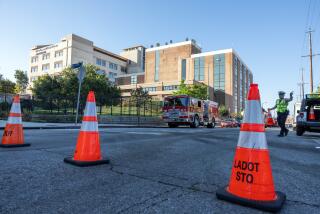Sandy’s urgent reminder to California
- Share via
Watching super storm Sandy ravage New York and New Jersey made two things abundantly clear. It’s time to stop double-guessing climate scientists, and it’s time to start focusing on building a modern-day infrastructure to accommodate our climate-changed reality.
Of all the horror stories that played out in Sandy’s path of destruction, one of the most shocking was the meltdown of two Manhattan hospitals -- New York University Langone Medical Center and Bellevue Hospital -- which not only suffered power outages but also couldn’t rely on backup generators. At Bellevue Hospital, 17 million gallons of seawater collected in its basement, compromising the generators. Think about that. At both hospitals, critical-care patients had to be evacuated.
Piers Morgan used his CNN soapbox to take Alan Aviles, president of the New York City Health and Hospitals Corp., to task for facilities that were unprepared, jeopardizing patients’ health and safety. He argued:
THEN AND NOW: Devastation from super storm Sandy
I find it quite shameful that two of New York’s major hospitals have suffered complete power outages, given the fact that there’ve been hurricanes before, from Irene onwards, which have threatened; that they’re on the water, these hospitals; there must be an ongoing threat. And then it was a week to prepare for what everybody was saying was the biggest storm New York would ever see. […]
But whichever way you explain this, it doesn’t change the fact that you have got hundreds of patients, many critically ill, many mothers with newborn children, all being ferried on Monday night, for example, from NYU into the eye of the worst storm ever. I can’t think of anything worse for a mother with a newborn child than to be ferried down nine flights of stairs by harassed nurses and then have to go out into a hurricane.
It does beg the question, if this was to happen again next year, would you have a different system that didn’t have, for example, pumps with oil in the basement, which then get drowned so much you can’t use them? I mean, what are the lessons that get learned here so that mothers who may be coming into these hospitals next year don’t have to worry that if there’s another hurricane, they’re going to be out in the middle of it? […]
Is it not your job as the president of New York City Health and Hospitals Corporation to think the unthinkable? And isn’t this just part of the unthinkable -- in other words a major attack through water? You are based near the water there. It can hardly be that unthinkable. But it has come in and has affected your power system to the extent that you have to evacuate hundreds of people. That is part of your job, isn’t it?
“It is very easy to make that judgment from a ringside seat,” Aviles said by way of defense. True. But we still ought to listen to this critique and find answers to the questions this fiasco raised before the next big disaster, wherever it may hit.
That’s especially true for us in California, where we have earthquake faults, nuclear power plants and the Pacific Ocean to contend with. And one place we can’t cut corners: medical facilities.
In an Op-Ed that ran in 2011’s Opinion pages, Assemblywoman Bonnie Lowenthal (D-Long Beach) questioned the wisdom behind cutting annual maintenance funds to our state’s three mobile hospitals, or “hospitals in a box,” which can be set up just about anywhere in case of emergency and are fully loaded: ventilators, respirators, antivirals, digital X-ray machines, oxygen concentration unit, hundreds of beds and separate emergency rooms, among other crucial amenities.
“California has about 73,000 acute-care beds among its 321 brick-and-mortar hospitals. A whopping 75% of those hospitals are in earthquake zones. State officials have identified nearly 600 separate hospital buildings that pose a real risk of collapse during a seismic event,” wrote Lowenthal, who also warned that these field hospitals would be as good as useless if we don’t spend the money -- a little less than $2 million annually -- needed to maintain them.
Sandy wreaked havoc on the East Coast, devastating people in New York and New Jersey. For some, there’s no silver lining in sight. But for us, on the West Coast, we should use Sandy as a call to action to prepare for worst-case scenarios, and that includes making sure that we don’t skimp on the most important things, like healthcare.
ALSO:
Sandy: Act of God or act of man?
Sandy churns up a little cyclone of trouble for Romney
Follow Alexandra Le Tellier on Twitter @alexletellier
More to Read
A cure for the common opinion
Get thought-provoking perspectives with our weekly newsletter.
You may occasionally receive promotional content from the Los Angeles Times.






